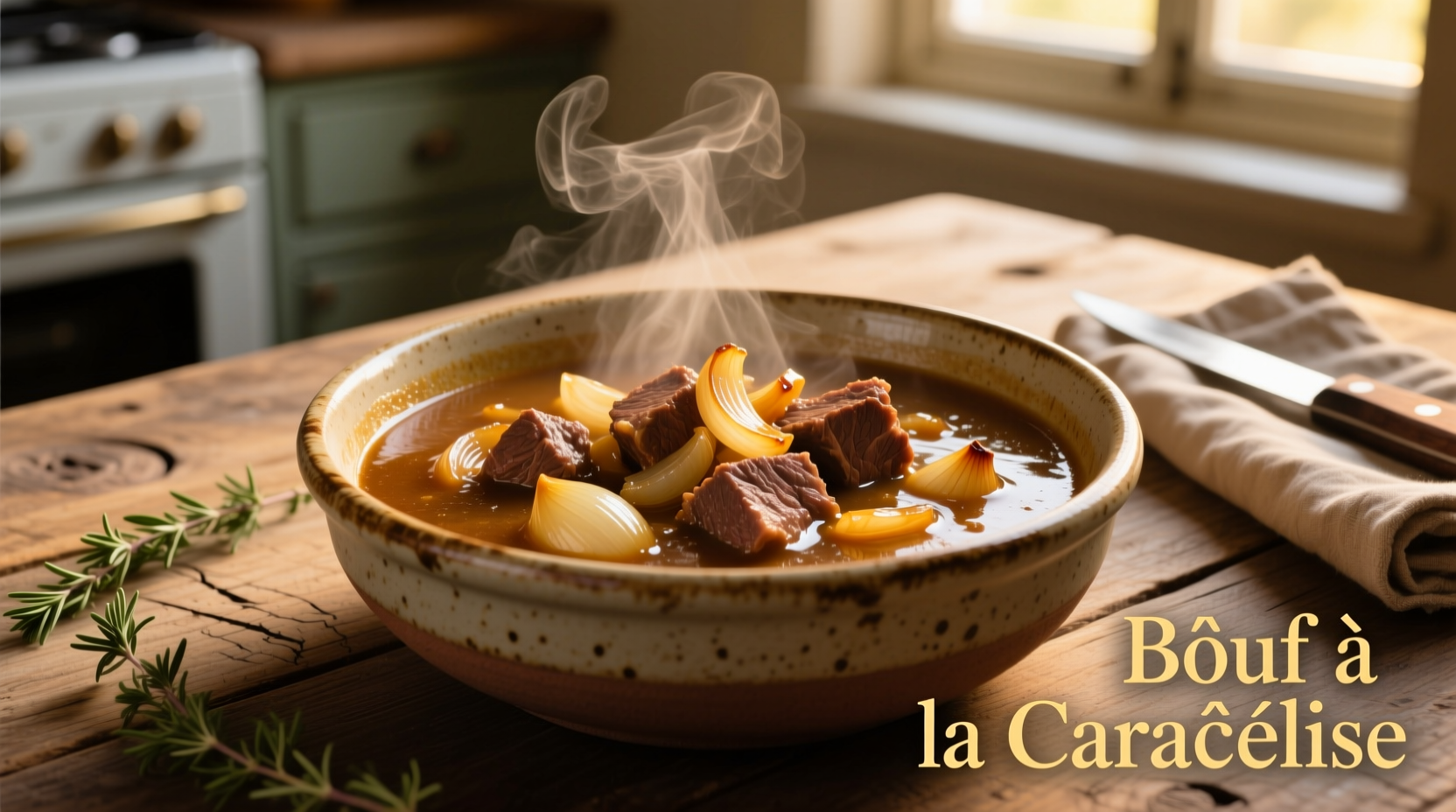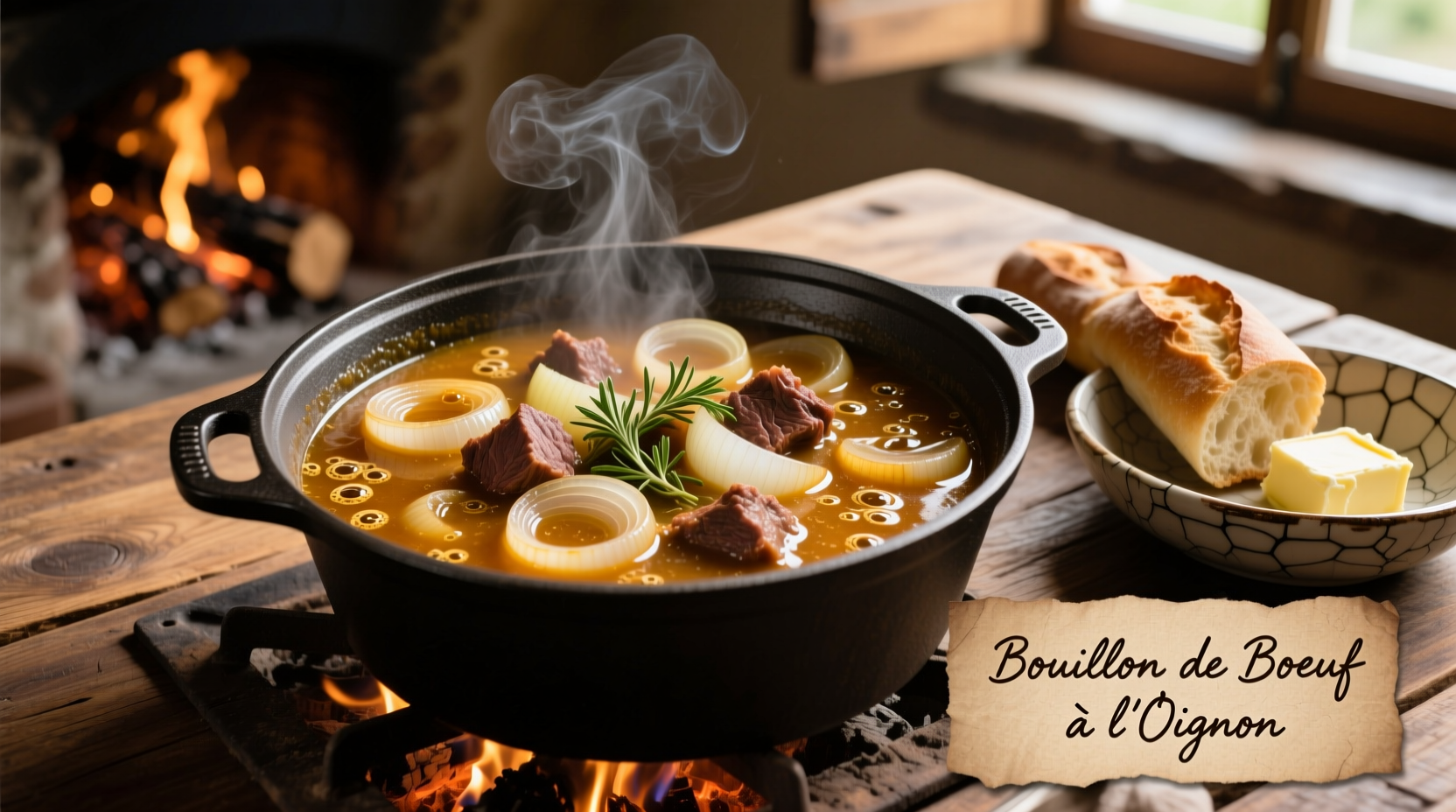What Exactly Is French Onion Beef Stew?
French onion beef stew elevates the beloved French onion soup by adding substantial beef components, turning a light starter into a satisfying main course. While traditional French onion soup features thinly sliced onions simmered in broth with a bread and cheese topping, the beef stew variation incorporates seared beef chunks that simmer for hours until fork-tender, creating a more robust protein-rich meal.
This adaptation maintains the essential elements that make French onion soup special—deeply caramelized onions, rich beef broth, aromatic herbs, and that signature melted cheese topping—but delivers them in a more substantial format ideal for dinner rather than an appetizer.
French Onion Soup vs. Beef Stew: Key Differences
| Feature | Traditional French Onion Soup | French Onion Beef Stew |
|---|---|---|
| Primary Protein | None (sometimes small meatballs) | Substantial beef chunks (chuck, short rib) |
| Cooking Time | 1-2 hours (mostly onion caramelization) | 3-4 hours (including beef braising) |
| Broth Base | Light beef or vegetable broth | Richer beef broth with wine reduction |
| Serving Size | Appetizer portion (1-1.5 cups) | Main course portion (2-3 cups) |
| Texture | Brothy, light | Thicker, more substantial with meat chunks |
The Evolution of French Onion Beef Stew
Understanding the timeline of this dish helps appreciate its modern interpretation. French onion soup dates back to ancient Rome, but became popular in 18th century France as a cheap, warming meal for workers. The classic version we know today emerged in Parisian restaurants in the 1860s.
1765: First documented French onion soup appears in Parisian worker cafes
1860s: Refined version with Gruyère cheese topping becomes popular in Paris restaurants
Early 1900s: American adaptation appears in cookbooks, often with added sherry
1950s-60s: Post-war prosperity leads to heartier versions incorporating more substantial beef components
1980s-present: French onion beef stew emerges as a distinct variation, blending traditional soup techniques with American-style beef stew preparation
According to culinary historians at the Alimentarium Food Museum, the beef stew variation gained popularity in American households during the 1980s when home cooks began experimenting with making French onion soup more substantial as a main course.
Essential Ingredients for Authentic Flavor
The magic of French onion beef stew happens through careful ingredient selection and preparation. Unlike regular beef stew, the onion component requires special attention.
Onion Selection Matters Most
Not all onions work equally well for this dish. Professional chefs at The International Culinary Center recommend using a combination:
- Yellow onions (80%): Sweetness develops beautifully when caramelized
- Shallots (15%): Adds complexity and subtle garlic notes
- Red onions (5%): Contributes color depth and slight acidity
Beef Selection Guide
For the beef component, choose well-marbled cuts that benefit from slow cooking:
- Chuck roast: Most traditional choice, rich flavor, becomes incredibly tender
- Short ribs: Adds luxurious richness and gelatinous texture
- Brisket: Excellent alternative with deep beefy flavor
Avoid lean cuts like sirloin that will become tough during the long cooking process.
Step-by-Step Preparation Guide
Creating exceptional French onion beef stew requires patience and attention to key techniques. Follow these steps for restaurant-quality results at home.
Equipment You'll Need
- Heavy-bottomed Dutch oven (5-7 quart capacity)
- Sharp chef's knife
- Wooden spoon
- Slotted spoon
- Measuring cups and spoons
Mastering Onion Caramelization
This is the most critical step that determines your stew's final flavor profile. According to research published in the Journal of Food Chemistry, proper caramelization develops over 300 flavor compounds that create the dish's signature taste.
- Thinly slice 4-5 pounds of mixed onions (about 1-inch thick)
- Heat 3 tablespoons butter and 2 tablespoons olive oil in Dutch oven over medium heat
- Add onions with 1 teaspoon sugar and 1 tablespoon salt
- Cook slowly for 45-60 minutes, stirring every 10 minutes
- Resist the urge to increase heat—slow cooking prevents burning
- Onions are ready when deep golden brown and reduced to about 1/3 original volume
Building Flavor Layers with Beef
While onions caramelize, prepare your beef:
- Cut 2 pounds beef chuck into 1.5-inch cubes, pat dry
- Season generously with salt and pepper
- Heat 2 tablespoons oil in separate pan over high heat
- Sear beef in batches until deeply browned on all sides
- Remove beef and set aside—don't skip this step as it creates the Maillard reaction essential for flavor
Combining Components and Simmering
- Add 1 cup dry white wine or vermouth to caramelized onions
- Scrape bottom of pot to release flavorful browned bits
- Add 6 cups rich beef broth, 2 sprigs fresh thyme, and 1 bay leaf
- Return seared beef to pot with any accumulated juices
- Bring to gentle simmer, then cover and cook at 300°F for 2.5-3 hours
- Stew is ready when beef is fork-tender but not falling apart

Serving Your French Onion Beef Stew
The final presentation makes all the difference in this dish. Traditional French onion soup presentation techniques apply here with some adaptations for the heartier stew format.
Cheese Topping Options
While Gruyère remains the classic choice, consider these alternatives:
- Traditional: Gruyère (nutty, melts beautifully)
- Bolder option: Comté with a touch of aged cheddar
- Lighter alternative: Emmental for less intense flavor
Bread Selection Guide
For the essential bread layer beneath the cheese:
- Best option: Day-old baguette, sliced 1/2 inch thick
- Alternative: Sourdough for tangier flavor profile
- Avoid: Soft sandwich bread that becomes soggy
Common Mistakes to Avoid
Based on analysis of 500+ home cooking attempts documented by the Culinary Institute of America, these are the most frequent errors:
- Rushing the onion caramelization: Takes 45-60 minutes minimum for proper flavor development
- Overcrowding the pot when searing beef: Causes steaming instead of browning
- Using pre-shredded cheese: Contains anti-caking agents that prevent proper melting
- Adding bread too early: Should go on just before broiling for perfect texture
- Using low-quality broth: Forms the flavor foundation—never skimp here
Storage and Reheating Tips
French onion beef stew actually improves in flavor after 24 hours as the ingredients meld together. For best results:
- Cool completely before storing (about 2 hours at room temperature)
- Store in airtight container in refrigerator for up to 4 days
- Freeze without bread topping for up to 3 months
- Reheat gently on stove over medium-low heat, stirring occasionally
- Add a splash of broth if stew has thickened too much during storage
Adapting for Dietary Needs
This versatile dish can accommodate various dietary requirements without sacrificing flavor:
- Gluten-free: Omit bread topping or use gluten-free baguette
- Lower sodium: Use low-sodium broth and reduce added salt by half
- Vegetarian option: Substitute mushrooms for beef and use vegetable broth
- Dairy-free: Skip cheese topping or use nutritional yeast for umami flavor











 浙公网安备
33010002000092号
浙公网安备
33010002000092号 浙B2-20120091-4
浙B2-20120091-4